 |
Hazard Communication Basic |
1.00 |
This course covers the basics when it comes to hazard communication. The topics will range from the Hazard Communication Standard to the labeling of hazardous materials. |
 |
Effective Communication with Children and Youth |
2.00 |
We are constantly communicating with the children and youth in our program through our words and actions. It's important for program staff to think critically about their communication skills and habits in order to communicate effectively. During this course, participants will learn about effective and dynamic communication tools, strategies to check for understanding, and activities that engage children and youth in communication. |
 |
Quality Management: The Costs of Quality (Instructor Guide) |
0.50 |
Before the quality revolution that began in the United States in the 1980s, quality was frequently viewed as a goal that came at a higher price for production. However, the reality is that poor quality is a result of the ineffective use of resources, including wasted material and labor. Therefore, improved quality means better use of resources and lower costs.
In this course you will learn to: identify the relationship between quality and cost, the benefits of establishing quality requirements, management’s responsibilities for achieving conformance, and the costs of customer dissatisfaction.
This Instructor's Edition of this course includes notes and suggestions to assist you in presenting the material, whether in an in-person classroom setting or as an instructor-led online or distance-learning course. It also provides you with the answers to questions found in mid-lesson activities, as well as in the quiz that concludes the course. |
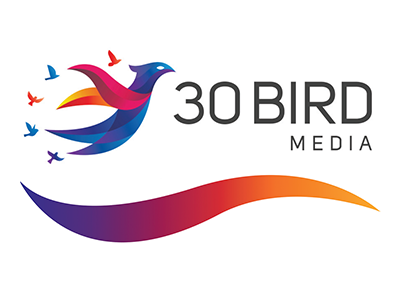 |
Microsoft Access 2019 Complete |
16.00 |
This course provides the basic and advanced concepts for the use of Microsoft Access 2019: How to navigate the Access interface; how to create and modify tables, queries, forms, and reports; how to create advanced queries, forms, and reports; how to create macros; and how to manage your databases.
You will benefit most from this course if you want to be an advanced user of Access 2019.
The course assumes you know how to use a computer, and that you're familiar with Microsoft Windows. It does not assume that you've used a different version of Access or another database system before. |
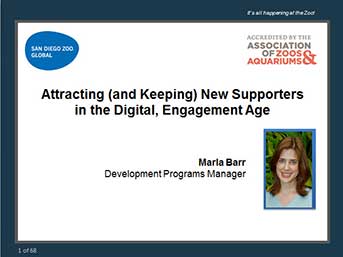 |
Attracting (and Keeping) New Supporters in the Digital, Engagement Age |
1.00 |
There are more non-profits in the market every day, but less donors. Is this a recipe for disaster, or an opportunity for us to transform what donor acquisition, retention and stewardship look like in our digital age? Join us during this 60 minute webinar to learn what innovative donor engagement in 2013 looks like by walking through some of the San Diego Zoo Global's recent digital campaign hits and misses to see how you can help your organization rise above this changing donor landscape. |
 |
Environmental Systems |
2.00 |
Many of the animals exhibited in zoos and aquariums have very specific environmental requirements that must be met in order to support the life form and better ensure its welfare. This course will explore the unique biological, physiological, and welfare requirements of several varied types of animals; their unique requirements; and the implications for the provision of these requirements. |
 |
Egress, Fire Prevention, & Fire Protection |
0.65 |
In this course, participants will learn about escape routes and exits, emergency action plans, fire prevention plans, fires, fire extinguishers, and workplace fire prevention tips. |
 |
Google Cloud: Associate Cloud Engineer Exam Prep |
1.00 |
Exam Prep to accompany 30 Bird's Google Cloud: Associate Cloud Engineer course. |
 |
Managing Performance: Legal Appraisals (Instructor Guide) |
0.84 |
In this course you will learn to: identify legal appraisals and responsibilities in relation to laws enforced by the EEOC, and identify risks of legal challenges and the importance of maintaining positive communication. |
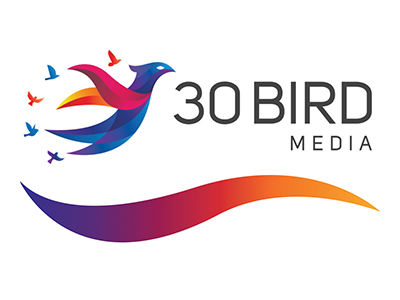 |
CompTIA A+ Certification Comprehensive - Exams 220-1101/220-1102 |
40.00 |
CompTIA A+ Certification Comprehensive - Exams 220-1101/220-1102 provides the basic knowledge needed to install, configure, and support computer software and implement networking. This includes:
- Applying basic methodical troubleshooting skills as an IT technician
- Identifying motherboard and CPU components, installing or replacing them, and troubleshooting their functions
- Identifying power supply functions and connectors, installing them into a PC, and troubleshooting power issues
- Configuring BIOS/UEFI firmware, identifying and installing RAM, and troubleshooting memory issues
- Comparing internal and external expansion buses on a computer, installing internal cards, and identifying expansion cables and connectors
- Distinguishing between physical storage technologies, installing drives, and troubleshooting storage problems
- Connecting, configuring, and troubleshooting common input-output devices
- Describing common printing technologies, installing and maintaining printers, and troubleshooting printing issues
- Identifying client operating system features, installing Windows and application software, and working with scripts
- Managing and troubleshooting operating systems using built-in administrative tools, such as the Windows Control Panel, Windows Settings, and command-line utilities
- Describing network principles, network devices, and internet connection technologies
- Identifying and categorizing network cables and connectors
- Configuring and troubleshooting issues related to TCP/IP and other network protocols
- Describing common wireless networking standards and encryption methods
- Configuring and troubleshooting problems with Windows resource sharing and network connections
- Identifying and using virtualization technology and cloud computing services
- Identifying types of mobile devices and operating systems, and configuring and troubleshooting mobile devices
- Recognizing common cybersecurity threats and the security controls which are used to reduce risk
- Identifying and using security features built into operating systems, as well as security hardware and software used on workstations and networks
- Securing workstations and mobile devices against security risks, and troubleshooting common security issues such as malware infection
- Applying best practices in IT operations, including policies, documentation, ticketing systems, incident response, and data backups and recovery
This course maps to the CompTIA A+ Certification 220-1101 and 220-1102 certification exams. You can download an objective map for the course from 30bird.com.
This course assumes that you have basic computer knowledge.
For exam practice, use the separate Exam Preps for exams 220-1101 and 220-1102:
- CompTIA A+ Core 1 220-1101 Exam Prep
- CompTIA A+ Core 2 220-1102 Exam Prep |
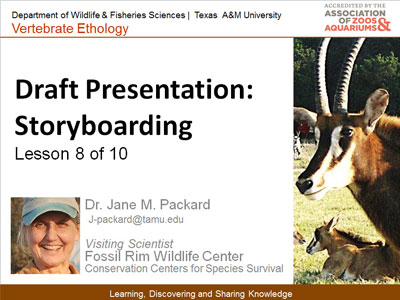 |
Draft Presentation: Storyboard of Results |
1.00 |
Your boss has asked you to present the results of your behavioral inquiry at a staff meeting. How do you tell the story of your project, providing enough detail so they will understand, but not too much so they will be able to focus on how this relates to the decision at hand? Listen to a research team present their draft presentation and offer suggestions about how this could be improved to enhance communication. Pick up some creative tips and offer a few of your own. |
 |
Foundational Literacy Strategies for Paraprofessionals |
1.00 |
This course covers foundational literacy strategies for paraprofessionals. It will walk you through different strategies you can use throughout the reading process. The content of this course is divided into three parts: strategies you can use before reading, during reading, and after reading. It is just one out of many paraprofessional courses we offer. This course will help you develop new knowledge about students and will help you better understand your role as a paraprofessional. |
 |
Collaboration with Team Members for Paraprofessionals |
1.00 |
This course covers collaboration with team members for paraprofessionals. You will learn what collaboration looks like in the school setting and what it means to use effective collaboration strategies. This course will also dive into what it means to be an effective communicator in the professional setting. |
 |
Advanced Interpersonal Communication: Communication Styles and Methods (Instructor Guide) |
0.75 |
To be successful in the workplace, you must be able to effectively communicate and cooperate with clients and co-workers. Learning about the four types of communication styles helps a listener understand a speaker’s perspective. It also helps a speaker understand how their communication affects the listener.
In this course you will learn: to identify primary and secondary communication styles, and to communicate using various verbal and nonverbal modes of communication.
This Instructor's Edition of this course includes notes and suggestions to assist you in presenting the material, whether in an in-person classroom setting or as an instructor-led online or distance-learning course. It also provides you with the answers to questions found in mid-lesson activities, as well as in the quiz that concludes the course. |
 |
Conflict and Communication: Why Can't We Be Friends? |
1.00 |
Conflict occurs when we are in relationship with others. In fact, the hallmark of a healthy relationship is not the absence of conflict, but the ability to successfully resolve it. Unfortunately, resolving conflict is not a skill many of us were taught. We'll explore the fundamental causes of conflict and the dynamics that can escalate conflict. Finally, we’ll cover the tools necessary to navigate conflict successfully, including effective communication strategies. |
 |
Reducing Foodborne Illness Risk Factors in Food Service and Retail Establishments |
0.50 |
This course covers different risk factors that are insufficiently controlled in institutions, retail food, and restaurants. Recommendations to help these places control these risk factors are also given. |
 |
Project Teams: Preparing Teams for Project Work (Instructor Guide) |
1.00 |
Building a project team is more complex than assigning employees to the team. Team members must feel a sense of dedication to other team members, as well as to the project itself. Members who are not dedicated to the project team often disregard meetings, deadlines, and commitments, causing the entire team to suffer. To avoid these problems, the team managers and supervisors need to encourage team building to benefit the project, the team members, and the organization.
In this course you will learn to: empower and motivate a project team and develop positive culture in a project team, identify the causes of change in a team and manage change, and improve existing project teams.
This Instructor's Edition of this course includes notes and suggestions to assist you in presenting the material, whether in an in-person classroom setting, or as an instructor-led online or distance-learning course. It also provides you with the answers to questions found in mid-lesson activities, as well as in the quiz that concludes the course. |
 |
Expedition Ocean: Module 1 Teacher Version |
1.00 |
|
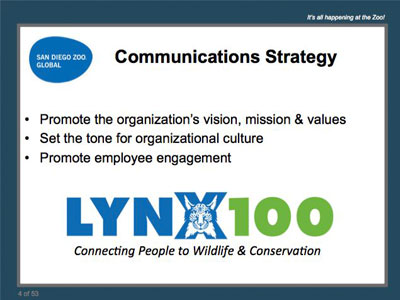 |
Creating a World Famous Employee Communications Strategy |
1.00 |
In recent years, San Diego Zoo Global's Internal Communications programs have been nationally recognized for excellence in outstanding employee communications. During this webinar, you will hear best practices from a seasoned pro at employee communications - covering latest trends, social media, employee forums, electronic newsletters, and creation of a cutting edge intranet for your organization. You will not want to miss this one...
|
 |
ROAR: How to Build a Resilient Organization the World-Famous San Diego Zoo Way |
0.75 |
Roar: How to Build a Resilient Organization the World-Famous San Diego Zoo Way shows leaders at any level how to unleash the full potential of their teams to create lasting organizational resiliency rivaling that of the world-famous San Diego Zoo. It will show how the Zoo’s operating organization, San Diego Zoo Global, has utilized a set of innovative programs to create its team of exceptional leaders and engaged employees who have engendered its amazing accomplishments.
Featuring real-world stories, best practices, and specific strategies based on 100 years of exceptional leadership, this unique and valuable resource will help organizations of any size and focus to master winds of change, overcome stress and adversity, thrive in times of chaos, and constant in pursuit of their vision, and accomplish extraordinary things. |
 |
Correcting Performance Problems: Disciplining Employees (Instructor Guide) |
1.67 |
Discipline is proactive, as opposed to punishment, which is reactive. Punishment provides a consequence to an action that is deemed unacceptable, whereas discipline is designed to exchange undesirable behavior for satisfactory behavior.
The purpose of disciplining an employee is twofold:
1. To correct or eliminate undesirable behavior, and
2. To provide training that improves or strengthens performance.
In this course you will learn to: keep a disciplinary perspective, determine the cause for disciplining an employee, and prepare for conducting a disciplinary meeting, maintain a positive rapport, avoid pitfalls during a disciplinary meeting with employees, and keep meetings productive, and monitor employee performance and conduct a follow-up meeting with the employee.
This Instructor's Edition of this course includes notes and suggestions to assist you in presenting the material, whether in an in-person classroom setting, or as an instructor-led online or distance-learning course. It also provides you with the answers to questions found in mid-lesson activities, as well as in the quiz that concludes the course. |
 |
Cultural Diversity in School Settings |
1.00 |
This course contains definitions of diversity, equity, and inclusion (DEI) and the role DEI plays in the school setting. Embracing diversity, equity, and inclusion benefits everyone within a K-12 institution: faculty, staff, students, and families.
Learners will reflect on the different elements of their own identity and how that impacts their perception of others. This course will also discuss the role of bias in the school setting. |
 |
Business Ethics: Whistle-Blowing (Instructor Guide) |
0.75 |
In this course you will learn to: identify criteria for whistleblowing and the risks associated with it, and identify when and how to blow the whistle. |
 |
Diversity, Equity, and Inclusion Training (Corrections) |
1.00 |
Diversity, Equity and Inclusion have become an important part of creating a culture that thrives on leveraging differences.
The goal is to learn:
Definitions of Diversity, Equity, and Inclusion
Why Diversity, Equity, and Inclusion is Important to Everyone?
Our Identity and Where it Comes From
Bias and The Impact to Others
Next Steps to Take |
 |
Organizational Communication: Power, Politics, and Diversity (Instructor Guide) |
0.75 |
Power is the ability to influence someone to do something that they would not do without encouragement. Various types of power and power strategies depend on the level of influence. The existence of different levels of power in an organization gives rise to organizational politics.
Politics can arise between individuals who differ from each another. To avoid confrontation arising from differences, it is important for people to recognize the benefits of diversity within their organization.
In this course you will learn to: identify different levels and types of power, identify strategies to manage diversity and to communicate in different cultures, and identify the steps and guidelines for empowerment.
This Instructor's Edition of this course includes notes and suggestions to assist you in presenting the material, whether in an in-person classroom setting, or as an instructor-led online or distance-learning course. It also provides you with the answers to questions found in mid-lesson activities, as well as in the quiz that concludes the course. |


























